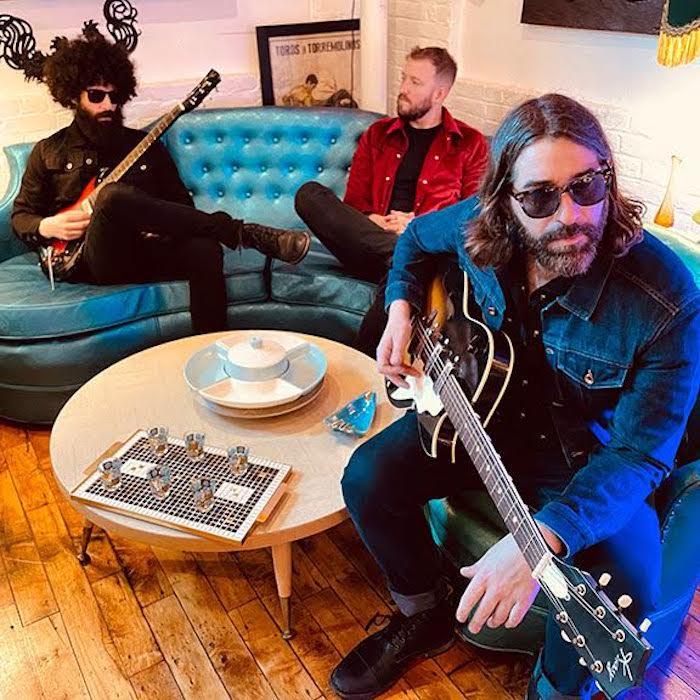
“I think all the songs are blues tunes but there’s definitely influences that are outside of just Chicago blues that made their way into the music.”
Local blues-rock trio GA-20 have gone beyond being just one of the best blues bands in New England. With their extensive touring around North America and Europe, vocalist and guitarist Pat Faherty, guitarist Matthew Stubbs, and drummer Tim Carman are on their way to becoming one of the elite blues entities worldwide.
The fact that GA-20 recently reached the top of the Billboard Blues Albums chart shows just how far the band has come. Their third studio album, Crackdown, that’s due out Sept. 9 via Colemine and Karma Chief Records starts a new chapter for the band. Tracks like “Dry Run,” “Easy On The Eyes,” “I Let Someone In,” and “Gone For Good” exhibit a foundational growth while incorporating small bits of other musical styles.
Stubbs and I spoke ahead of Crackdown’s release about the making of the project, having it be the first time Carman played on an original record as part of the band, the groovy-looking sticker on the cover, and what he hopes people take away from the album.
Crackdown is GA-20’s second full-length album of original material following your 2019 debut album Lonely Soul. First off, where was it recorded and produced, did you have anyone assisting in the production, and what was the experience like making the album?
We recorded Crackdown at Q Division Studios in Somerville at Studio B. I produced it, Matt Beaudoin was the engineer, and Pat DiCenso and I mixed it together. The experience was good, we’ve been working on these songs for quite a while before we went into the studio and we recorded in kind of the same style we did with both Lonely Soul and the Hound Dog Taylor record where we set up live in the room. All the amps and drums were together and we mostly played everything live, there were a few overdubs on there but it’s basically an exact follow up to Lonely Soul. There’s nine originals and one cover song on this one.
This is the first original album with Tim Carman on drums, right?
Yeah, first original. He was on that Hound Dog Taylor tribute record that we put out a year ago but during the making of Lonely Soul he wasn’t in the band yet.
Did he bring any different dimensions or ideas from behind the kit when it came to fleshing out the songs? What was it like having him in the fray?
It was great. Tim joined the band back in 2019 and on this particular record Pat and I wrote most of the stuff but there’s one tune we all co-wrote together called “Double Gettin.’” We had the song in a different arrangement at the time and it was one of the songs that was giving us a little bit of trouble while trying to figure out what we were going to do with it. Then Tim actually came up with that drum beat so we ended up co-writing that one all together.
From listening to the album from start to finish, there’s a bit more of both a country and an instrumental vibe within the album. This is especially true with the title track being similar to what you’ve done with the Antiguas. What inspired this musical direction? Was it just from what you, Tim and Pat have been listening to or was it something else?
The instrumental side of things and from what you just mentioned with the Antiguas, it’s something that I’ve always been interested in. I always try to sneak in one instrumental song on our albums, there’s one on Lonely Soul as well. It’s kind of a trademark that I try to do, I enjoy instrumental music from the ’50s and ’60s and it always speaks to me. We always try to include at least one so that’s why that one is on there and it’s still a blues record but we were all listening to different stuff while we were writing the songs. Pat and I were listening to a lot of country music like you mentioned and also some garage rock which kind of snuck in there.
It’s still a blues record. I think all the songs are blues tunes but there’s definitely influences that are outside of just Chicago blues that made their way into the music.
You can notice the hints of garage rock and country within the songs. One thing I really got a kick out of from seeing the album cover is that there’s this sticker saying “Always Fresh” on it. The design has a retro vibe, it looks like something from the late ’60s with a pink and black color combo. Who had the idea to put that sticker on the album cover? Who designed it and how did it all come about?
The idea actually was from the guy who owns our record label, Terry Cole of Colemine Records. It first started as just a design thing because the record is a black and white photo with silver foil; when you see it, it’s almost like a mirror. It’s very stark with just two colors and he designed the LP cover but he wanted to add a vibrant color so we came up with that. It goes along with what we’re trying to bring this traditional music, this traditional blues, to people who might not be aware of it. To me, all those old records still sound fresh. When I hear blues from the late ’50s or early ‘60s, it’s very timeless so that’s kind of where it came from.
Blues is still one of the most timeless genres of music out there today and it’s great that you guys are still pushing it forward. What do you aim to accomplish with the listener when they press play and dive into what Crackdown has to offer?
I’d say that it’s probably the same goal as everything we’ve put out up to this point where we want to write our own songs in that blues genre from music that inspired us. Hopefully some of the people that find us and hear this record, they might not be blues lovers yet or know a lot about traditional blues, but when they put this on it’s something that speaks to them. After they listen to our record, maybe they’ll dig back a little bit and start listening to these old blues cats that they might not have heard of until they got into GA-20.
Rob Duguay is an arts & entertainment journalist based in Providence, RI who is originally from Shelton, CT. Outside of DigBoston, he also writes for The Providence Journal, The Connecticut Examiner, The Newport Daily News, Worcester Magazine, New Noise Magazine, Northern Transmissions and numerous other publications. While covering mostly music, he has also written about film, TV, comedy, theatre, visual art, food, drink, sports and cannabis.

